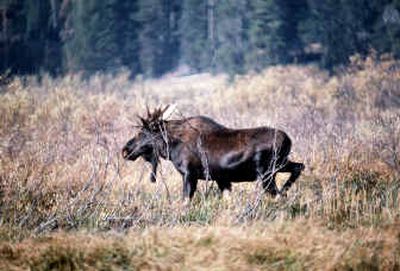Moose Loose

Infrequent guests through the years, moose have been moving into the northeast corner of Oregon in greater numbers, much as they started moving into northeastern Washington decades ago.
And they’ve been showing with increasing frequency throughout northeastern Washington, where they’re more commonly seen than elk.
“It is an interesting, novel thing for us,” said Bruce Eddy, acting regional manager at the Oregon Department of Fish and Wildlife’s office in La Grande. “They obviously found something they like.”
The moose are likely traveling from Idaho, where their numbers have exploded from about 500 in 1947 to more than 20,000 today.
The mountains, forests and rivers northeast of La Grande offer an ideal home for the animals that stand 6 feet high at the shoulder, brandish antlers 5 feet wide and weigh up to half a ton.
“I expect you’ll see them colonize the northeast corner of the state in significant numbers,” said Dale Toweill, trophy species coordinator for the Idaho Department of Fish and Game. “They’re great wanderers, and they’ll cross some pretty developed areas to get where they want to go.”
Many have roamed into Washington, where the animals were mostly unknown four decades ago. Today they number about 1,000 and are still increasing, expanding across the prairies of Eastern Washington and attracting crowds as they amble all around Mount Spokane, along the Little Spokane River, Hangman Creek and even through the neighborhoods of Spokane.
In the summer of 1999, a moose that had lost its wariness brought its calf into neighborhoods and took over the swimming pool of a home near Chattaroy before they were tranquilized and hauled away.
“It’s still, even as they grow in numbers, such a great novelty,” said Madonna Luers of the Washington Department of Fish and Wildlife. “People love to see them.”
Although she advises people to avoid feeding them because they can become dangerous.
People love to hunt them, too.
Last year, 13,003 hunters applied to the lottery drawing for 94 moose hunting permits offered in Washington. That compares with 41,499 applicants for 7,548 special elk tags, although hunters who do not draw a special elk tag can still hunt spike elk with a general over-the-counter tag.
Moose tags, however, are, in most cases, a once in a lifetime privilege in Washington.
Cost of the moose tags for those who beat the odds in the drawing are $109.50 for state residents and $1,095.50 for non-residents.
Moose are listed as a game animal in Oregon, but there is no legal hunting season.
That’s pretty much the stage Eastern Washington was in prior to 1977, when the state’s first moose hunt debuted with three permits in the Selkirk Unit of Pend Oreille County.
Oregon biologists link the takeoff of moose in the Northwest to logging. Though it’s often blamed for harming wildlife, it’s done the opposite for moose. Some shrubs and trees flourish in the wake of logging, offering moose shelter plus the stems, leaves, buds and bark the thrive on for sustenance.
“When you log, or when fires go through, you get all kinds of new growth for them to eat,” said Vince Crichton, a moose expert and senior scientist at Manitoba Conservation in Canada. “They are very adaptable if there’s enough food around.”
In Wyoming, however, the factors appear to be working against moose.
Moose populations in western Wyoming have fallen so low the Game and Fish Department is considering closing the hunting season in parts of the region.
The agency is teaming with the Wyoming Department of Transportation to study why populations are falling, and what can be done about it.
“There’s still a lot of speculation out there as to why our moose population continues to decline …,” Jackson wildlife biologist Doug Brimeyer said in a statement. “Some say it’s predators, some say it’s habitat, drought or poor nutrition, at this point we really don’t know.”
Overall moose numbers in the region have gone down over the years, forcing Wyoming Game and Fish to respond by reducing the number of hunting permits. A record 495 moose permits were issued in 1991; that number dropped to just 75 permits last year.
“To this point, our only tool to help this herd has been to reduce the hunting pressure,” Brimeyer said. “We’ve been reducing the number of permits in the Teton Wilderness hunt areas for 10 years now, but the population has continued to decline.”
Some have blamed the introduction of predators, particularly wolves, for the drop in moose populations.
But Joel Berger, a senior scientist with the Wildlife Conservation Society, said a decade-long study he conducted showed that wolves had little effect on moose populations.
Berger’s study indicated that malnutrition and starvation were the main culprits in the drop in moose populations. About 14 to 18 percent of mortality in the Jackson area was caused by grizzly bears, and about 8 percent were caused by car crashes. Wolves accounted for just 2 percent.
Brimeyer said the new study would build on Berger’s findings.